There are 50 states in the United States, but only eight of them start with the letter “N.” Can you name them all? Check out this list of states that start with the letter “N” and learn about their geography, population, climate, and wildlife.
1. Nebraska
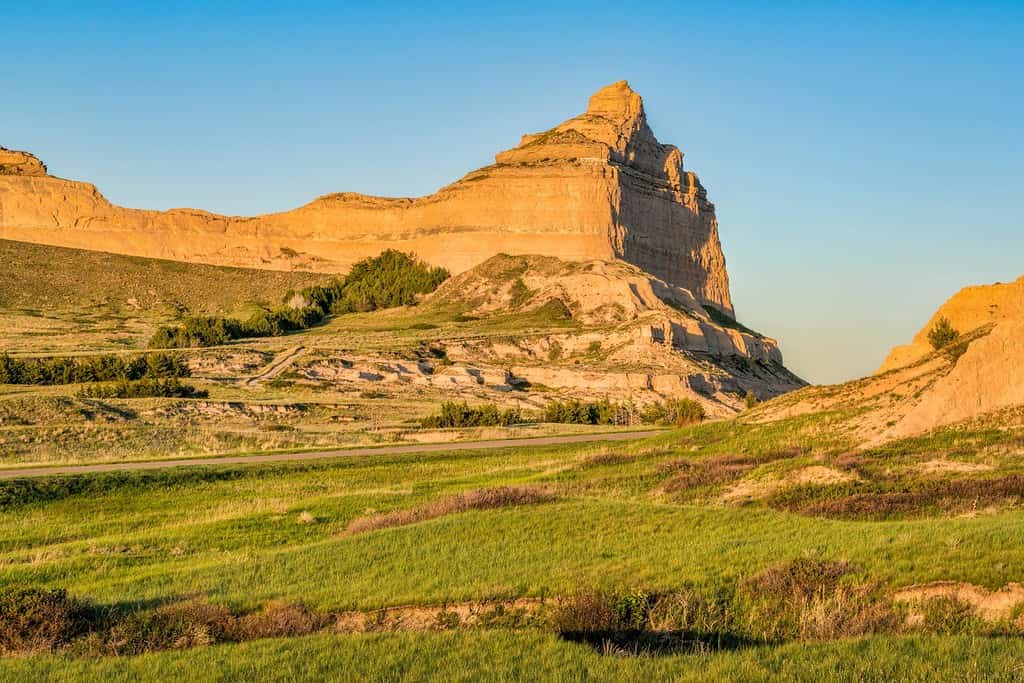
The National Park Service protects Scotts Bluff National Monument in western Nebraska.
©marekuliasz/Shutterstock.com
Nebraska is a midwestern state located in the center of the U.S. in the Great Plains. The Cornhusker State was the 37th state to join the country. Bordered by South Dakota to the north and Kansas to the south, Nebraska also shares borders with Iowa, Colorado, and Wyoming. Lincoln, the state’s capital, is home to around 300,000 of the state’s 1.964 million residents.
There are two major regions in Nebraska. Covered in flat, treeless prairies, the Great Plains region makes up most of western Nebraska. The Dissected Till Plains region that encompasses most of the rest of the state is full of gently rolling hills. Nebraska has a continental climate and temperatures vary between seasons, with hot summers and cold winters.
Wildlife aficionados in Nebraska can expect to see a variety of animals, including bighorn sheep, elk, prairie dogs, pronghorn, plovers, bald eagles, sandhill cranes, prairie rattlesnakes, western fox snakes, common snapping turtles, and Great Plains skinks.
2. Nevada
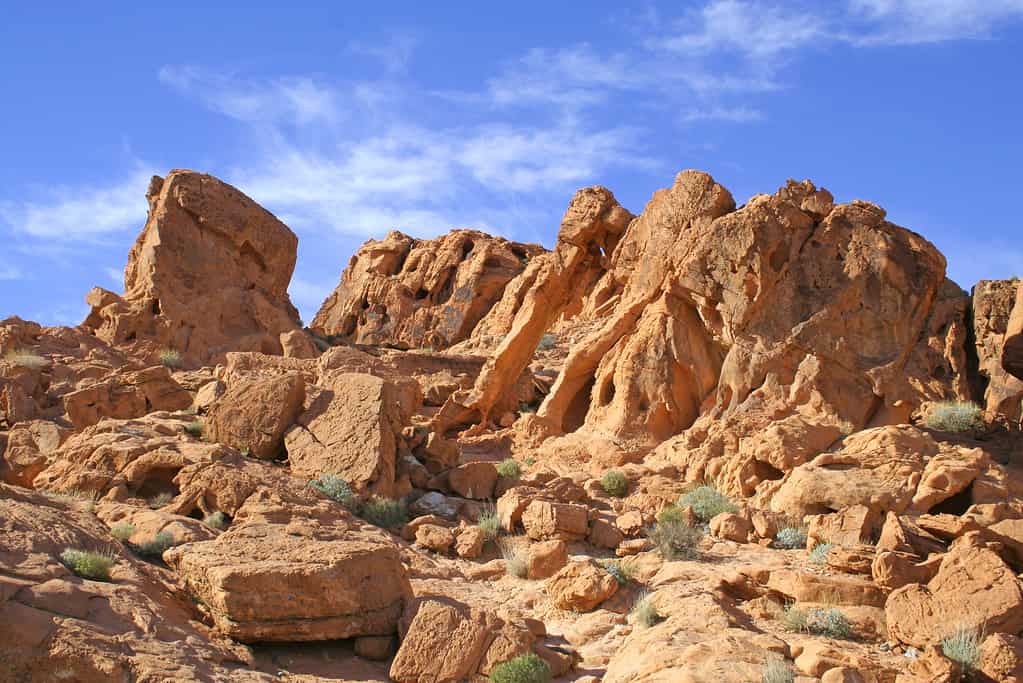
Elephant
Rock is a rock formation in Valley of Fire State Park in Nevada.
©Walt Snover/iStock via Getty Images
Located in the Western United States, Nevada shares its entire western border with California. Oregon, Idaho, Utah, and Arizona also border the Silver State, one of the least densely populated states in the country. The seventh-biggest state in landmass, Nevada ranks 32nd in population, with 3.144 million residents. Nevada’s capital is Carson City, but it is famous for the bright lights of Las Vegas.
But Nevada isn’t all gambling and nightlife: the state’s geography is also enchanting. Mostly covered by desert, Nevada is the driest state. However, it also shares part of Lake Tahoe, the second-deepest lake in the country. The state is also known for its northern mountains, which have long cold winters.
Commonly seen animals in Nevada include mountain lions, mule deer, pronghorns, foxes, American badgers, Gila monsters, desert tortoises, rattlesnakes, sidewinders, zebra-tailed lizards, American white pelicans, California spotted owls, California quail, grouse, and ferruginous hawks.
3. New Hampshire

The state of New Hampshire is nicknamed “The Granite State.”
©Wirestock/iStock via Getty Images
The small New England state of New Hampshire is known for its charm and untouched wilderness. Tucked between Vermont, Maine, Massachusetts, and the Atlantic Ocean, New Hampshire shares its northern border with the Canadian province of Quebec. The capital city of Concord is in the central south area of the state that is home to 1.389 million people.
Being so far north, New Hampshire has long, cold, snowy winters. The state is largely covered by conifer and hardwood forests, but there are salt marshes along the coast. New Hampshire is also known for its mountains, which are full of opportunities for skiing and hiking.
Hikers in New Hampshire may encounter a variety of wildlife, including black bears, bobcats, coyotes, fishers, moose, bats, beavers, timber rattlesnakes, white-tailed deer, eastern milk snakes, osprey, golden eagles, gyrfalcons, and goshawks.
4. New Jersey
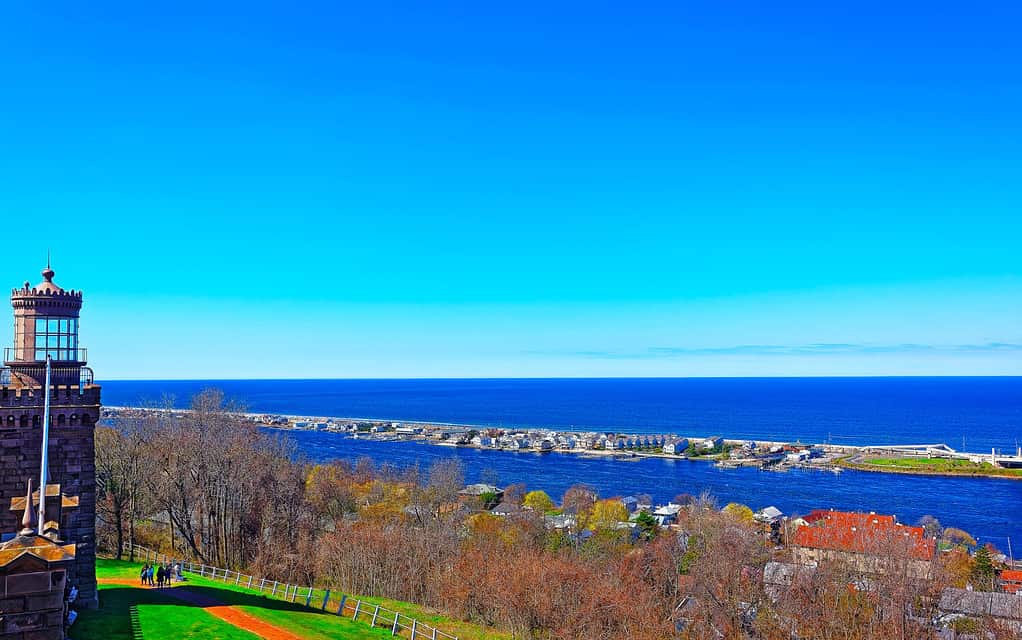
Navesink Twin Lights is a nonoperational lighthouse in Monmouth County, New Jersey.
©Roman Babakin/Shutterstock.com
New Jersey is known for the Jersey Shore, as over 130 miles of the state border the Atlantic Ocean. The state is also bordered by New York, Pennsylvania, and Delaware. The state’s capital of Trenton lies near the Pennsylvania line. Although the state is small, it has a population of 9.267 million people.
Like most mid-Atlantic/northeastern states, New Jersey has a moderate climate with hot, humid summers and cold winters. New Jersey also features coastal plains and forests. The foothills of the Appalachian Mountains are in the hilly northwestern portion of the state.
New Jersey also has an abundance of wildlife. River otters, mink, muskrats, raccoons, beavers, black bears, bats, black racer snakes, blue herons, American goldfinches, Pine Barrens tree frogs, copperheads, and over 300 species of fish are found in the state and its surrounding waters.
5. New Mexico
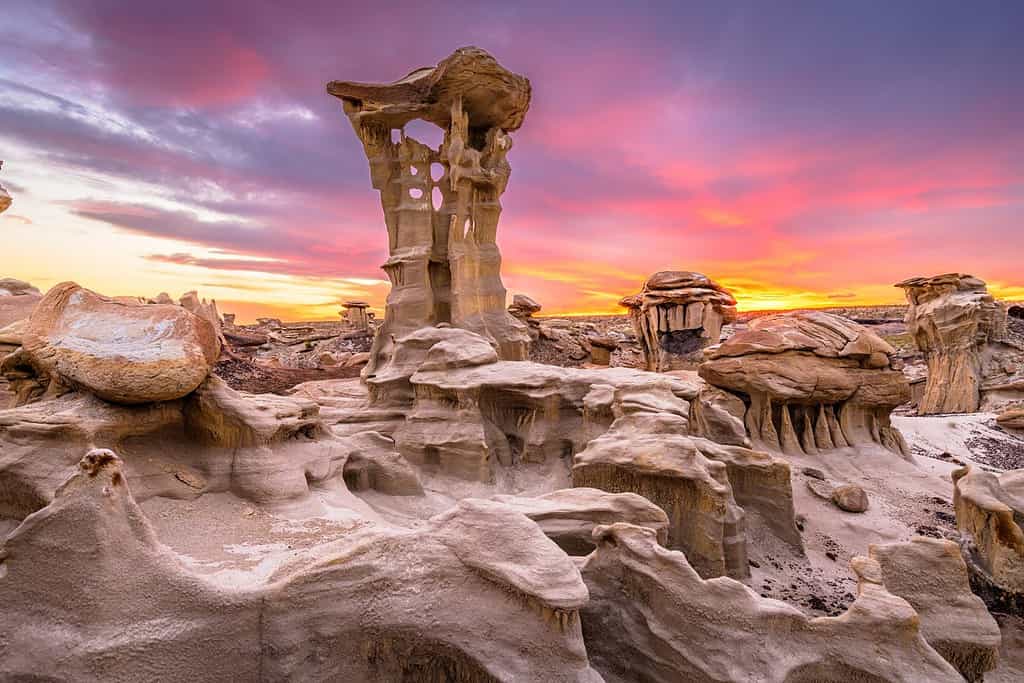
Alien Throne is located in a field of hoodoos on Navajo Nation land in New Mexico.
©Sean Pavone/Shutterstock.com
The fifth-largest state, New Mexico is tucked away in the American southwest. Bordered by Arizona, Utah, Colorado, Oklahoma, Texas, and Mexico, New Mexico is home to 2.116 million people. Its capital city is Santa Fe, located in the northern central part of the state.
New Mexico has some of the country’s flattest land, alongside mountains, pine forests, and deserts. The climate is arid and dry throughout most of the state, though some mountains have snow-capped peaks. Carlsbad Caverns National Park and White Sands National Park are popular destinations.
Common wildlife in New Mexico includes dusty grouse, elk, belted kingfishers, eagles, whiptail lizards, spadefoot toads, black bears, chaparral birds, prairie dogs, peccaries, mountain lions, and mule deer.
6. New York
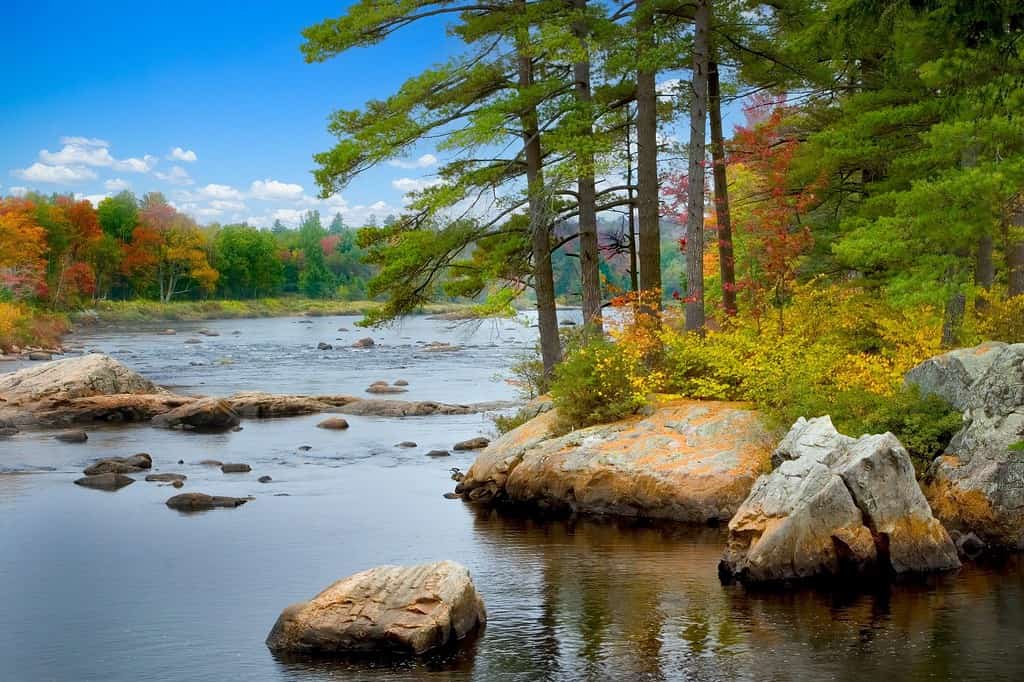
The Moose River runs through the Adirondack Mountains in northeastern New York.
©Jim Schwabel/Shutterstock.com
The Empire State is home to the iconic New York City, but the state’s capital is actually Albany. Located on the northeastern coast of the United States, New York is bordered by Pennsylvania, New Jersey, Connecticut, Massachusetts, Vermont, and Canada. The fourth-most populous state, New York has 19.6 million residents.
New York is also home to Niagara Falls and has temperate deciduous forests and mountains. Lake Erie, Lake Ontario, and the Niagara River border New York in the north. Its climate is considered humid continental, with four seasons. Summers are hot and winters are cold. Some northern portions of the state get large amounts of snow during the winter months.
There are lots of wild animals throughout New York, including white-tailed deer, beavers, skunks, coyotes, raccoons, Virginia opossums, piping plovers, red foxes, eastern chipmunks, box turtles, rodents, American oystercatchers, and gulls.
7. North Carolina
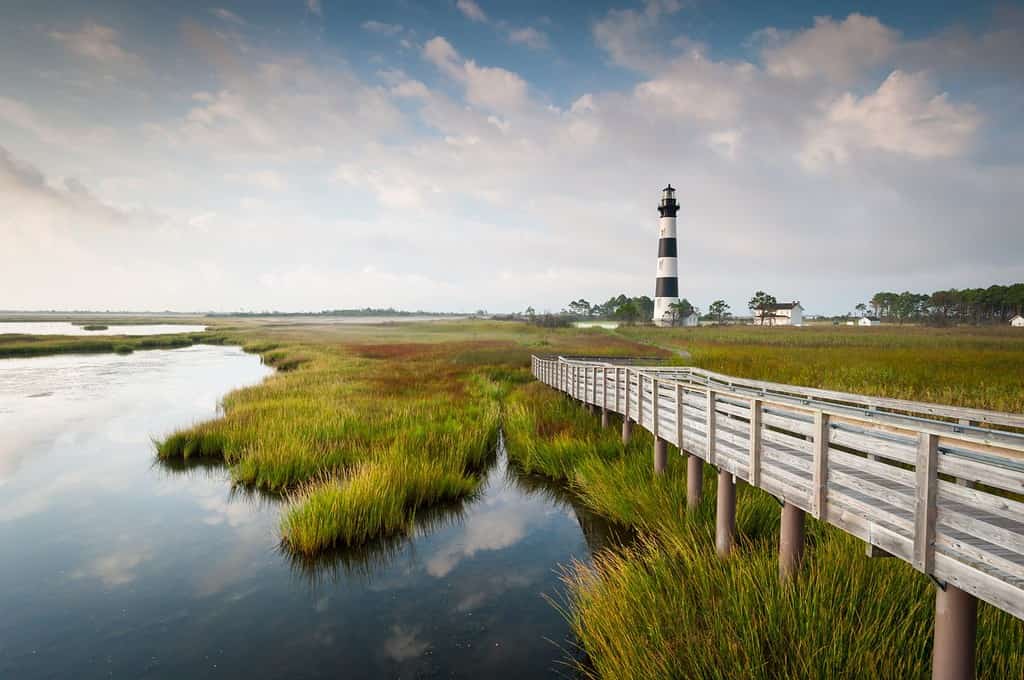
The Outer Banks is a popular place for vacationers.
©MarkVanDykePhotography/Shutterstock.com
On the southeastern seaboard of the Atlantic Ocean lies North Carolina. Bordered by Virginia to the north, Tennessee to the west, and Georgia and South Carolina to the south, North Carolina’s coastline is popular with beachgoers. Over 10.5 million people live in North Carolina, with 470,000 in the state’s capital of Raleigh.
North Carolina is very warm and humid with mild winters. Because the state has many different geographic areas, temperatures vary by locale. For example, the inland Appalachian Mountains experience cooler temperatures than the coastal plains.
Many types of wildlife can be found in the state due to the distinct ecosystems. Animals include black bears, coyotes, eastern chipmunks, bobcat, beavers, armadillos, alligators, laughing gulls, sandpipers, American white ibis, terns, aquatic salamanders, and the incredibly endangered red wolf.
8. North Dakota
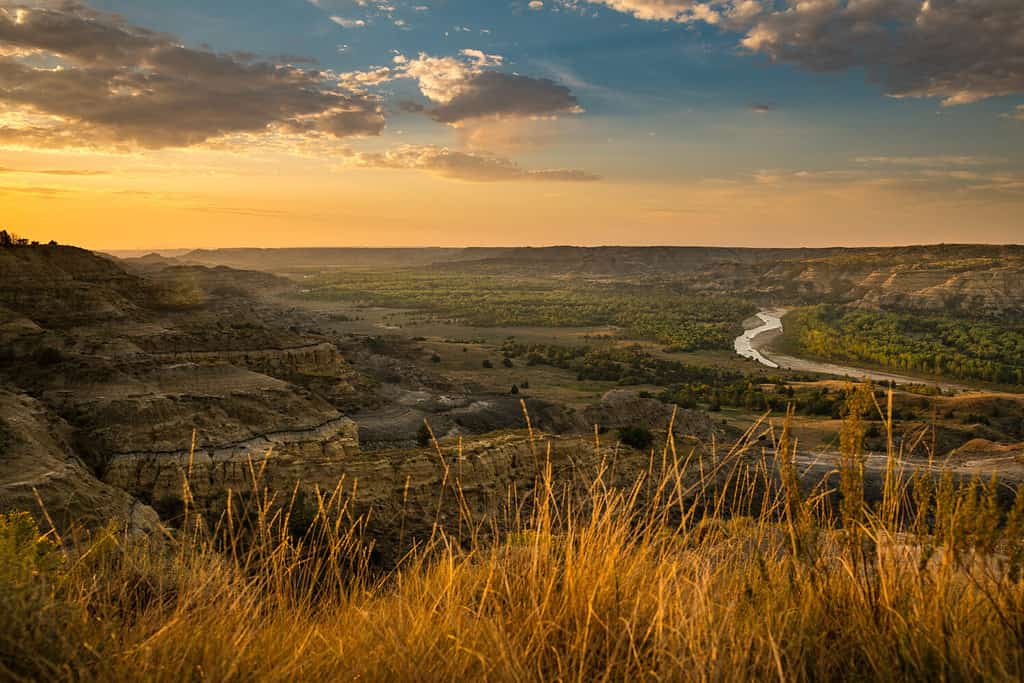
The prairies of North Dakota border Canada.
©TobyG/Shutterstock.com
Although North Dakota is the 19th largest state, it is the fourth-least populated in the country. It has a population of around 780,000. North Dakota is located on the northern America Midwest border with Canada. Minnesota, South Dakota, Montana, and the Canadian provinces of Manitoba and Saskatchewan border North Dakota. The capital of the Roughrider State is Bismarck, but the state’s largest city is Fargo.
North Dakota contains three natural regions: the Red River Valley, the Missouri Plateau, and the Drift Prairie. Elevation increases across the state from east to west, starting in the Red River Valley and ending in the Missouri Plateau. The state is known for its flat prairies, which make great land for agriculture. The climate is continental and changes by season.
Wildlife in North Dakota is typical of the Midwestern plains, and includes buffalo, deer, antelope, elk, golden eagles, ferrets, beavers, raccoons, red foxes, mountain lions, moose, American kestrels, greater prairie chickens, and woodpeckers.
The photo featured at the top of this post is © Sean Pavone/iStock / Getty Images Plus via Getty Images
Thank you for reading! Have some feedback for us? Contact the AZ Animals editorial team.






